Study on Spatiotemporal Evolution and Driving Forces of Habitat Quality in the Basin along the Yangtze River in Anhui Province Based on InVEST Model
Abstract
:1. Introduction
2. Materials and Methods
2.1. Study Area
2.2. Data Source and Processing
2.3. Methodology
2.3.1. InVEST Model and Habitat Quality Evaluation Process
2.3.2. Hot and Cold Spot Analysis
2.3.3. Geographical Detector
3. Results
3.1. Land Use Change
3.2. Analysis of Spatiotemporal Evolution of Habitat Quality
3.2.1. Characteristics of Spatiotemporal Differentiation of Habitat Quality
3.2.2. Analysis of Hot and Cold Spots of Habitat Quality Degradation
3.3. Analysis of Driving Forces for Spatial Differentiation of Habitat Quality
3.3.1. Key Driving Factors
3.3.2. Analysis of Driving Mechanism
4. Discussion and Conclusions
4.1. Discussion
4.2. Conclusions
Author Contributions
Funding
Institutional Review Board Statement
Informed Consent Statement
Data Availability Statement
Acknowledgments
Conflicts of Interest
References
- Wu, Y.; Pan, Y.X.; Zhang, B.Y.; Dai, F.B.; Tian, Y. Regional assessment on biodiversity and ecosystem services and policy experience within the IPBES framework. Biodivers. Sci. 2020, 28, 913–919. [Google Scholar] [CrossRef]
- Fan, Y.L.; Hu, N.; Ding, S.Y.; Liang, G.F.; Lu, X.L. Progress in terrestrial ecosystem services and biodiversity. Acta Ecol. Sin. 2016, 36, 4583–4593. [Google Scholar]
- Yang, Y.; Zhang, C.; Li, B.G. Practice and exploration of global biodiversity research and protection supported by biobank. Biodivers. Sci. 2021, 29, 1425–1433. [Google Scholar] [CrossRef]
- Mao, L.; Swenson, N.G.; Sui, X.; Zhang, J.; Chen, S.; Li, J.; Peng, P.; Zhou, G.; Zhang, X. The geographic and climatic distribution of plant height diversity for 19,000 angiosperms in China. Biodivers. Conserv. 2020, 29, 487–502. [Google Scholar] [CrossRef]
- Perino, A.; Pereira, H.M.; Felipe-Lucia, M.; Kim, H.; Kühl, H.S.; Marselle, M.R.; Meya, J.N.; Meyer, C.; Navarro, L.M.; van Klink, R.; et al. Biodiversity post-2020: Closing the gap between global targets and national-level implementation. Conserv. Lett. 2022, 15, e12848. [Google Scholar] [CrossRef]
- Huang, M.Y.; Yue, W.Z.; Feng, S.R.; Zhang, J.H. Spatial-temporal evolution of habitat quality and analysis of landscape patterns in Dabie Mountain area of west Anhui province based on InVEST model. Acta Ecol. Sin. 2020, 40, 2895–2906. [Google Scholar]
- Liu, F.T.; Xu, E.Q. Comparison of spatial-temporal evolution of habitat quality between Xinjiang Corps and Non-corps Region based on land use. Chin. J. Appl. Ecol. 2020, 31, 2341–2351. [Google Scholar]
- Mo, J.; Yang, Q.R.; Peng, W.Q.; Luo, H.H.; Huang, Y.L.; Bai, X.; Chen, D.H. Habitat quality evaluation of Yongding River in Beijing Mountain Section after ecological rehydration. China Rural. Water Hydropower 2021, 460, 30–36. [Google Scholar]
- Zhang, X.; Li, Y.X.; Lv, C.J.; Bi, R.T.; Xia, L.; Guo, Y.S.; Wang, Y.; Xu, C.C.; Sun, B. Research progress on application of ecosystem service functions based on InVEST model. Ecol. Sci. 2022, 41, 237–242. [Google Scholar]
- Peng, J.; Xu, F.X.; Wu, J.; Deng, K.; Hu, T. Spatial differentiation of habitat quality in typical tourist city and their influencing factos mechanisms: A case study of Huangshan City. Resour. Environ. Yangtze Basin 2019, 28, 2397–2409. [Google Scholar]
- Shang, J.; Cai, H.S.; Long, Y.; Zeng, J.Q.; Chen, Y.; Zhang, X.L. Temporal-spatial distribution and transition of habitat quality in Poyang Lake region based on InVEST model. Resour. Environ. Yangtze Basin 2021, 30, 1901–1915. [Google Scholar]
- Xia, Y.; Zhang, Y.Y.; Li, E.H.; Cai, X.B.; Yang, C.; Yang, J. Spatio-temporal evolution and prediction of habitat quality in four lakes basin of Jianghan Plain. Resour. Environ. Yangtze Basin 2022, 31, 1616–1626. [Google Scholar]
- Meng, Q.L.; Li, M.Y.; Ren, C.Y.; Wang, Z.M.; Tian, Y.L. Dynamic assessment of habitat quality in eastern Jililn Province based on HSI model. Remote Sens. Land Resour. 2019, 31, 140–147. [Google Scholar]
- Zhong, X.; Yang, N.; Zhang, L.; Cheng, Y.H.; Feng, Q.; Hu, Q.; Jin, Y.G. Population survey and habitat quality assessment of Lophophorus lhuysii in the Wolong National Nature Reserve. Sichuan J. Zool. 2021, 40, 509–516. [Google Scholar]
- Fu, B.; Wang, Y.K.; Xu, P.; Yan, K.; Li, M. Value of ecosystem hydropower service and its impact on the payment for ecosystem services. Sci. Total Environ. 2014, 472, 338–346. [Google Scholar] [CrossRef]
- Pan, Y.; Yin, Y.H.; Hou, W.J.; Han, H.S. Spatiotemporal variation of habitat quality in the Source Region of the Yellow River based on land use and vegetation cover changes. Acta Ecol. Sin. 2022, 42, 7978–7988. [Google Scholar]
- Wu, L.L.; Wang, S.Y.; Yang, R.X.; Ma, Y.X.; Guan, Y.L.; Liu, W.H.; Hai, K. Spatio-temporal patterns and differentiations of habitat quality for Asian elephant (Elephas maximus) habitat of Sri Lanka. Natl. Remote Sens. Bull. 2021, 25, 2472–2487. [Google Scholar]
- Han, Y.L.; Chen, K.L.; Yu, D.Y. Evaluation on the impact of land use change on habitat quality in Qinghai Lake basin. Ecol. Environ. Sci. 2019, 28, 2035–2044. [Google Scholar]
- Zhang, H.B.; Wang, J.; Liu, Y.Q.; Han, S.; Zhang, Y.N. Effects of human activities and the expansion of Spartina alterniflora on the evolution of habitat quality of the coastal wetland: Taking the core area of Yancheng National Nature Reserve as an example. Resour. Environ. Yangtze Basin 2021, 30, 1153–1163. [Google Scholar]
- Zhou, T.; Chen, W.X.; Li, J.F.; Liang, J.L. Spatial relationship between human activities and habitat quality in Shennongjia Forest Region from 1995 to 2015. Acta Ecol. Sin. 2021, 41, 6134–6145. [Google Scholar]
- Terrado, M.; Sabater, S.; Acuna, V. Identifying regions vulnerable to habitat degradation under future irrigation scenarios. Environ. Res. Lett. 2016, 11, 114025. [Google Scholar] [CrossRef]
- Dong, J.; Zhang, Z.; Liu, B.; Zhang, X.; Zhang, W.; Chen, L. Spatiotemporal variations and driving factors of habitat quality in the loess hilly area of the Yellow River Basin: A case study of Lanzhou City, China. J. Arid. Land 2022, 14, 637–652. [Google Scholar] [CrossRef]
- Wei, Q.; Abudureheman, M.; Halike, A.; Yao, K.; Yao, L.; Tang, H.; Tuheti, B. Temporal and spatial variation analysis of habitat quality on the PLUS-InVEST model for Ebinur Lake Basin, China. Ecol. Indic. 2022, 145, 109632. [Google Scholar] [CrossRef]
- Zhong, C.; Bei, Y.; Gu, H.; Zhang, P. Spatiotemporal Evolution of Ecosystem Services in the Wanhe Watershed Based on Cellular Automata (CA)-Markov and InVEST Models. Sustainability 2022, 14, 13302. [Google Scholar] [CrossRef]
- Chen, J.; Dong, B.; Li, H.; Zhang, S.; Peng, L.; Fang, L.; Zhang, C.; Li, S. Study on landscape ecological risk assessment of Hooded Crane breeding and overwintering habitat. Environ. Res. 2020, 187, 109649. [Google Scholar] [CrossRef] [PubMed]
- Zhao, J.H.; Wang, S.S.; Tu, G.J.; Zhou, Y.K.; Wu, X.B. Morphological and molecular characterization of Ortleppascaris sinensis sp. nov (Nematoda: Ascaridoidea) from the Chinese alligator Alligator sinensis. J. Helminthol. 2016, 90, 303–311. [Google Scholar] [CrossRef]
- Wu, J.; Cheng, S.P.; Li, Z.; Guo, W.J.; Zhong, F.; Yin, D.Q. Case study on rehabilitation of a polluted urban water body in Yangtze River Basin. Environ. Sci. Pollut. Res. 2013, 20, 7038–7045. [Google Scholar] [CrossRef]
- Yang, Y.; Tang, X.L.; Jia, Y.Y.; Zhan, Q.Q. Spatial-temporal coupling coordination and driving factors of population-land-economy urbanization in the Yangtze River Basin. World Reg. Stud. 2021, 30, 978–990. [Google Scholar]
- Chen, S.; Chen, Y.; Feng, T.Z.; Chao, L. Evaluation of the Status of Natural Habitat Restoration in the Liao River’s Riparian Zone. Pol. J. Environ. Stud. 2021, 30, 2509–2526. [Google Scholar] [CrossRef]
- Serafin, A.; Pogorzelec, M.; Banach-Albinska, B.; Zalewska, E.; Bronowicka-Mielniczuk, U.; Arciszewski, M. The Importance of Groundwater Quality and Other Habitat Parameters for Effective Active Protection of an Endangered Plant Species in Eastern Poland. Water 2022, 14, 1270. [Google Scholar] [CrossRef]
- Wang, Y.L.; Lan, A.J.; Fan, Z.M.; Lin, S.S.; Zhu, N. Spatial-temporal differentiation and driving factors of habitat quality in the Chishui River Basin based on InVEST model. China Rural. Water Hydropower 2023, 483, 17–23. [Google Scholar]
- Wu, J.Y.; Luo, J.A.; Zhang, H.; Qin, S.; Yu, M.J. Projections of land use change and habitat quality assessment by coupling climate change and development patterns. Sci. Total Environ. 2022, 847, 157491. [Google Scholar] [CrossRef]
- Yan, S.J.; Wang, X.; Cai, Y.P.; Li, C.H.; Yan, R.; Cui, G.N.; Yang, Z.F. An Integrated Investigation of Spatiotemporal Habitat Quality Dynamics and Driving Forces in the Upper Basin of Miyun Reservoir, North China. Sustainability 2018, 10, 4625. [Google Scholar] [CrossRef]
- Tang, Y.; Zhu, W.P.; Zhang, H.; Song, Y. A review on principle and application of the InVEST model. Ecol. Sci. 2015, 34, 204–208. [Google Scholar]
- Bao, Y.B.; Liu, K.; Li, T.; Hu, S. Effects of land use change on habitat based on InVEST model. Arid. Zone Res. 2015, 32, 622–629. [Google Scholar]
- Gong, J.; Ma, X.C.; Zhang, L.L.; Liu, D.Q.; Zhang, J.X. Spatiotemporal variation of habitat quality in Bailongjiang Watershed in Gansu based on InVEST model. Res. Soil Water Conserv. 2018, 25, 191–196. [Google Scholar]
- Yang, J.; Xie, B.P.; Zhang, D.G. Spatial-temporal evolution of habitat quality and its influencing factors in the Yellow River Basin based on InVEST model and GeoDetector. J. Desert Res. 2021, 41, 12–22. [Google Scholar]
- Zhou, X.Z.; Wen, H.J.; Zhang, Y.L.; Xu, J.H.; Zhang, W.G. Landslide susceptibility mapping using hybrid random forest with Geo Detector and RFE for factor optimization. Geosci. Front. 2021, 12, 361–379. [Google Scholar] [CrossRef]
- Wang, H.; Gao, J.B.; Hou, W.J. Quantitative attribution analysis of soil erosion in different morphological types of geomorphology in karst areas: Based on the geographical detector method. Acta Geogr. Sin. 2018, 73, 1674–1686. [Google Scholar]
- Zhang, J.J.; Li, X.H.; Batbayar, N.; Xu, Z.G.; Cao, L.; Fox, A.D. Exploring potential reasons for the increase in the East Asian Greylag Goose Anser anser population by assessing habitat use and use of protected areas. Bird Conserv. Int. 2023, 33, E22. [Google Scholar] [CrossRef]
- An, A.; Zhang, Y.; Cao, L.; Jia, Q.; Wang, X. A potential distribution map of wintering Swan Goose (Anser cygnoides) in the middle and lower Yangtze River floodplain, China. Avian Res. 2018, 9, 43. [Google Scholar] [CrossRef]
- Ao, P.R.; Wang, X.; Solovyeva, D.; Meng, F.J.; Ikeuchi, T.; Shimada, T.; Park, J.; Gao, D.; Liu, G.; Hu, B.; et al. Rapid decline of the geographically restricted and globally threatened Eastern Palearctic Lesser White-fronted Goose Anser erythropus. Wildfowl 2020, S6, 206–243. [Google Scholar]
- Li, W.B.; Wang, D.Y.; Li, H.; Liu, S.H. Urbanization-induced site condition changes of peri-urban cultivated land in the black soil region of northeast China. Ecol. Indic. 2017, 80, 215–223. [Google Scholar] [CrossRef]
- McCoshum, S.; Geber, M.A. Land Conversion for Solar Facilities and Urban Sprawl in Southwest Deserts Causes Different Amounts of Habitat Loss for Ashmeadiella Bees. J. Kans. Entomol. Soc. 2019, 92, 468–478. [Google Scholar] [CrossRef]
- Platenberg, R.J.; Harvey, D.S. Endangered species and land use conflicts: A case study of the Virgin Islands Boa (Epicrates Granti). Herpetol. Conserv. Biol. 2010, 5, 548–554. [Google Scholar]
- Zhao, L.P.; Li, X.C.; Li, X.M.; Ai, C.Y. Dynamic Changes and Regional Differences of Net Carbon Sequestration of Food Crops in the Yangtze River Economic Belt of China. Int. J. Environ. Res. Public Health 2022, 19, 13229. [Google Scholar] [CrossRef]
- Cheng, B.; Zhu, X.D.; Alatalo, J.M.; Gordon, J.; Li, H.Q.; Jiang, B.; Yin, W. The impacts of water level fluctuations from paddy fields and aquaculture ponds on wetland habitats for wintering waterbirds: Implications for wetland management. Front. Environ. Sci. 2022, 10, 980201. [Google Scholar] [CrossRef]
- Peng, L.; Dong, B.; Wang, P.; Sheng, S.; Sun, L.; Fang, L.; Li, H.; Liu, L. Research on ecological risk assessment in land use model of Shengjin Lake in Anhui province, China. Environ. Geochem. Health 2019, 41, 2665–2679. [Google Scholar] [CrossRef]
- Wang, C.; Dong, B.; Zhu, M.; Huang, H.; Cui, Y.H.; Gao, X.; Liu, L.P. Habitat selection of wintering cranes (Gruidae) in typical lake wetland in the lower reaches of the Yangtze River, China. Environ. Sci. Pollut. Res. 2019, 26, 8266–8279. [Google Scholar] [CrossRef]
- Zhang, Y.; Fox, A.D.; Cao, L.; Jia, Q.; Lu, C.H.; Prins, H.H.T.; de Boer, W.F. Effects of ecological and anthropogenic factors on waterbird abundance at a Ramsar Site in the Yangtze River Floodplain. Ambio 2019, 48, 293–303. [Google Scholar] [CrossRef]
- Zhou, B.H.; Cao, J.J.; Zhu, C.P.; Jin, B.S. Valuation of wetland ecosysytem services along the Yangtze River in Anqing, Anhui Province. Geogr. Res. 2011, 30, 2296–2304. [Google Scholar]
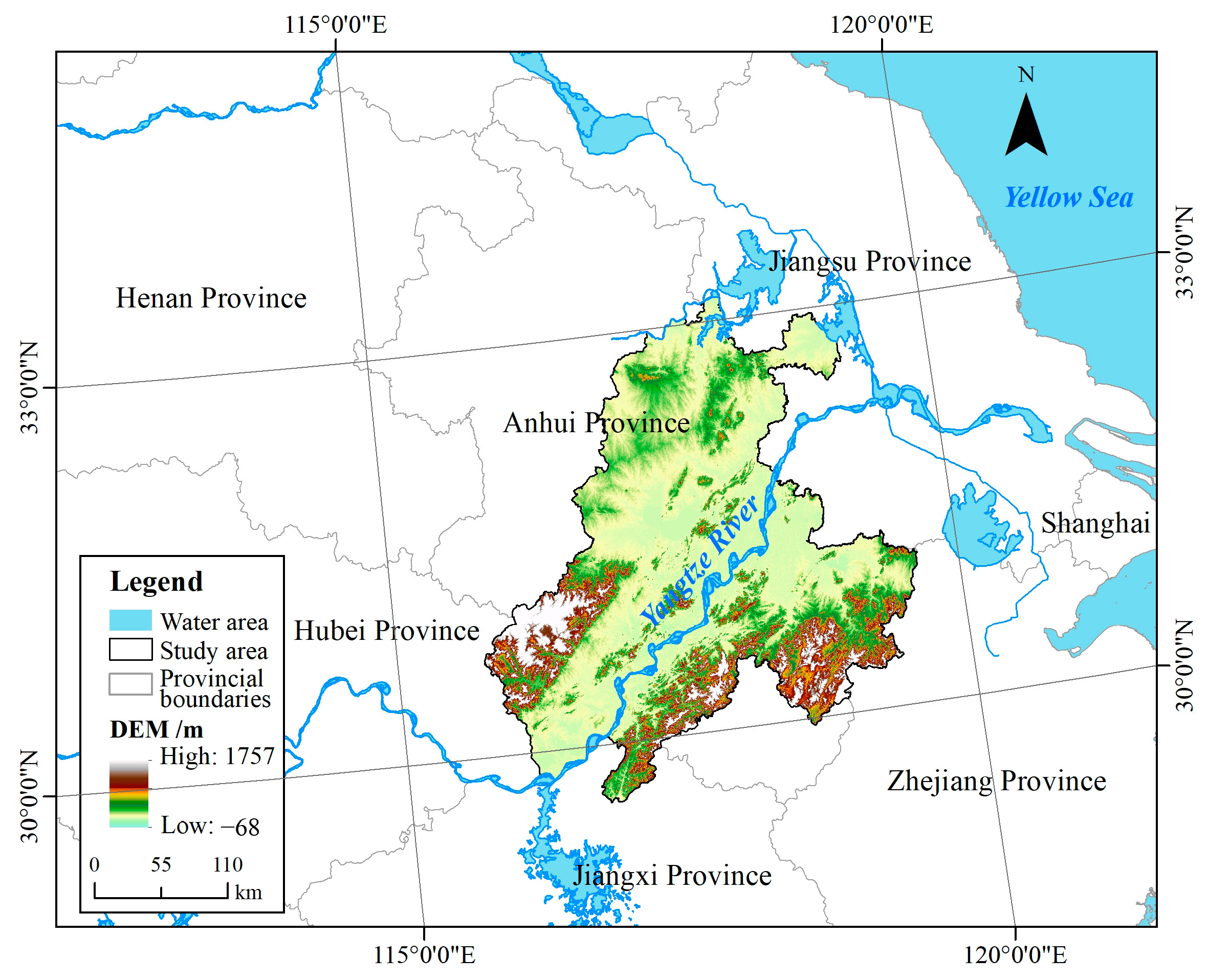

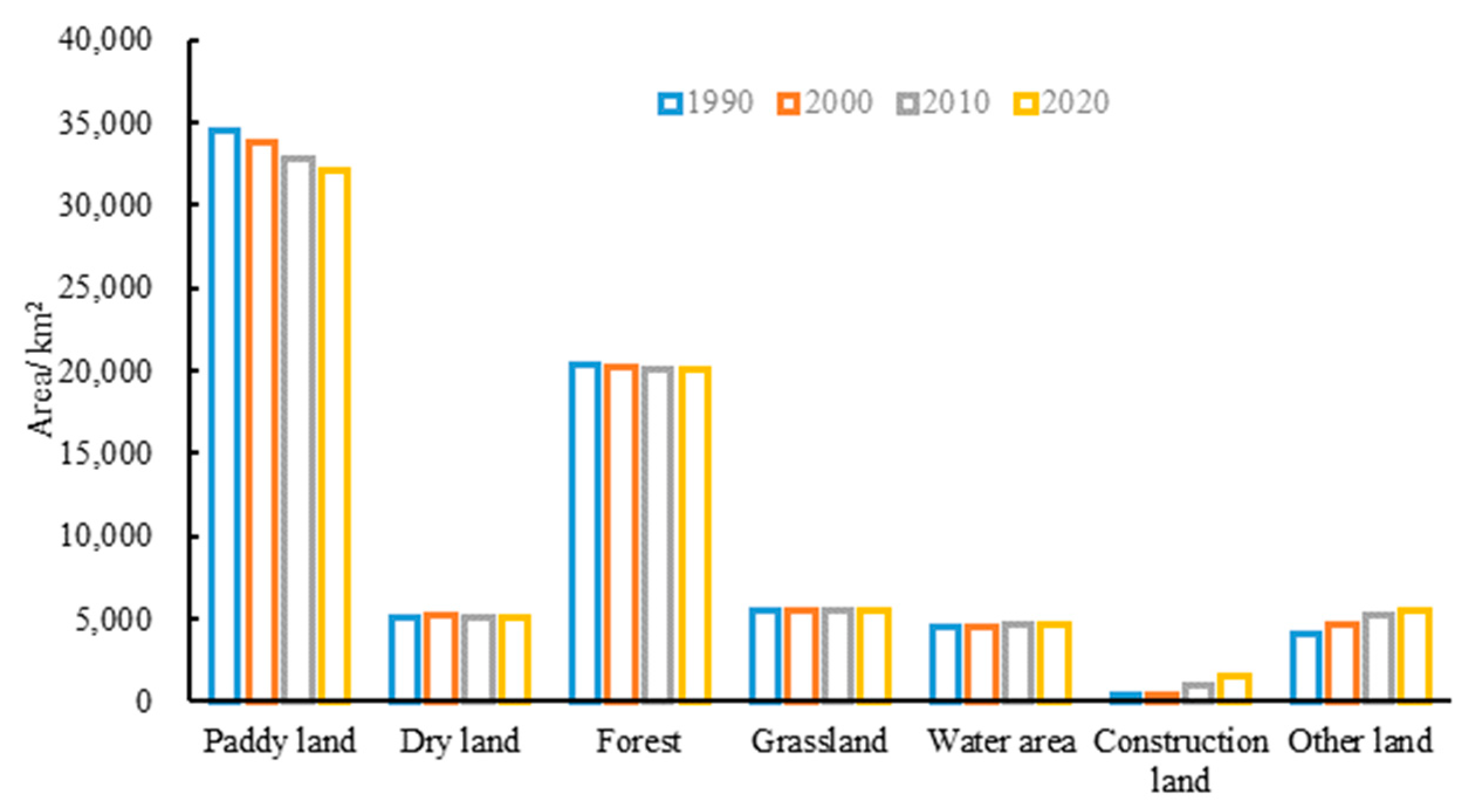

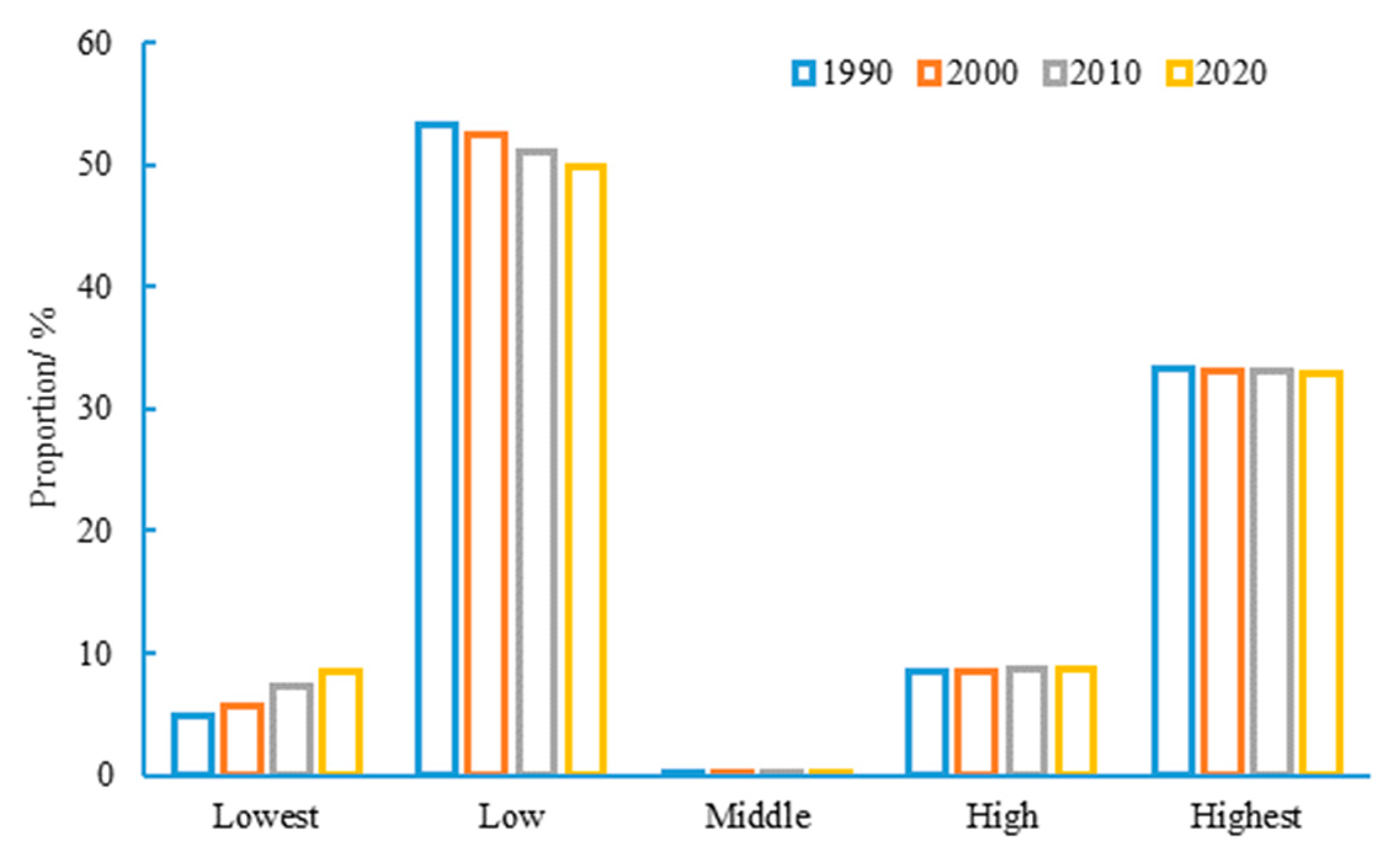
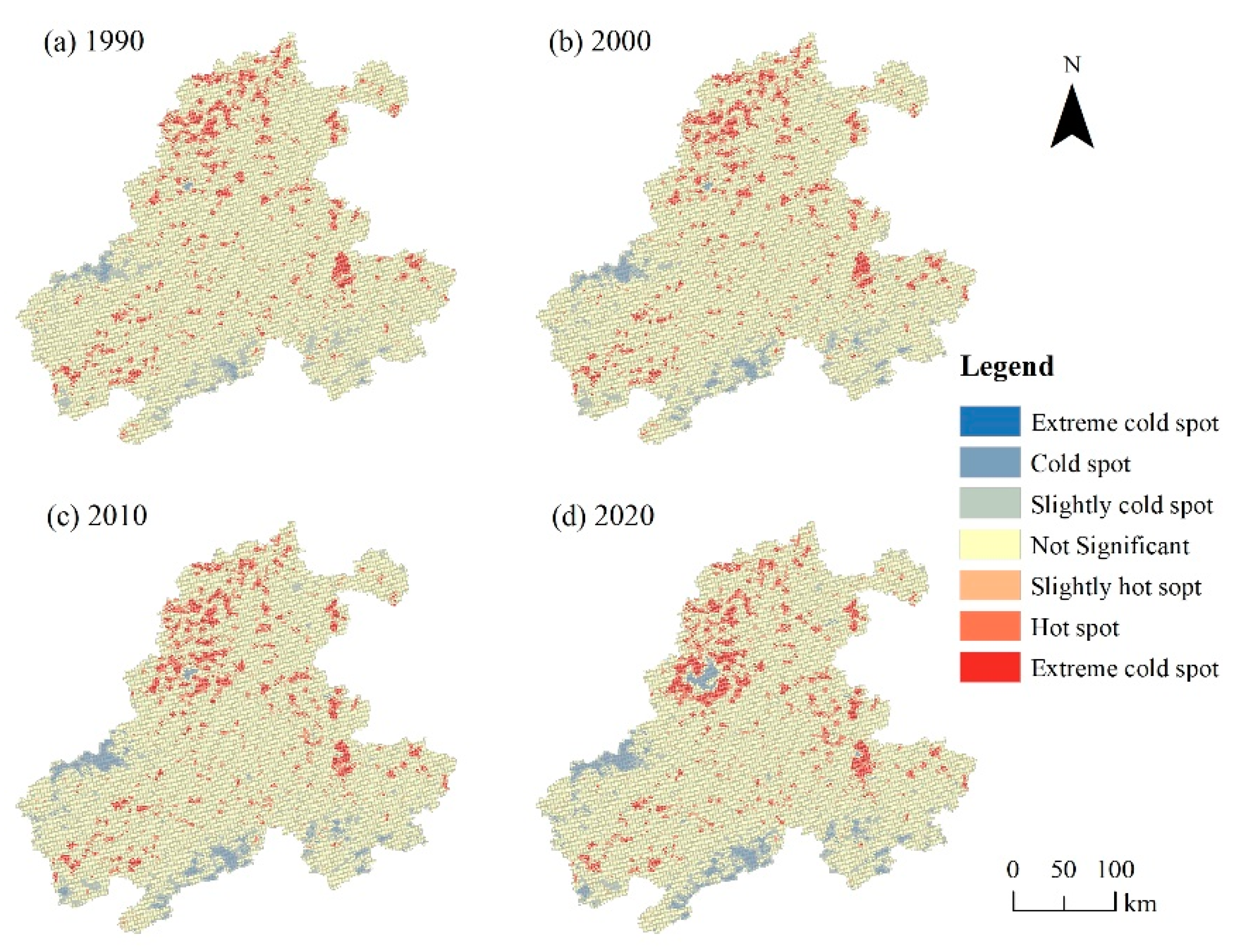
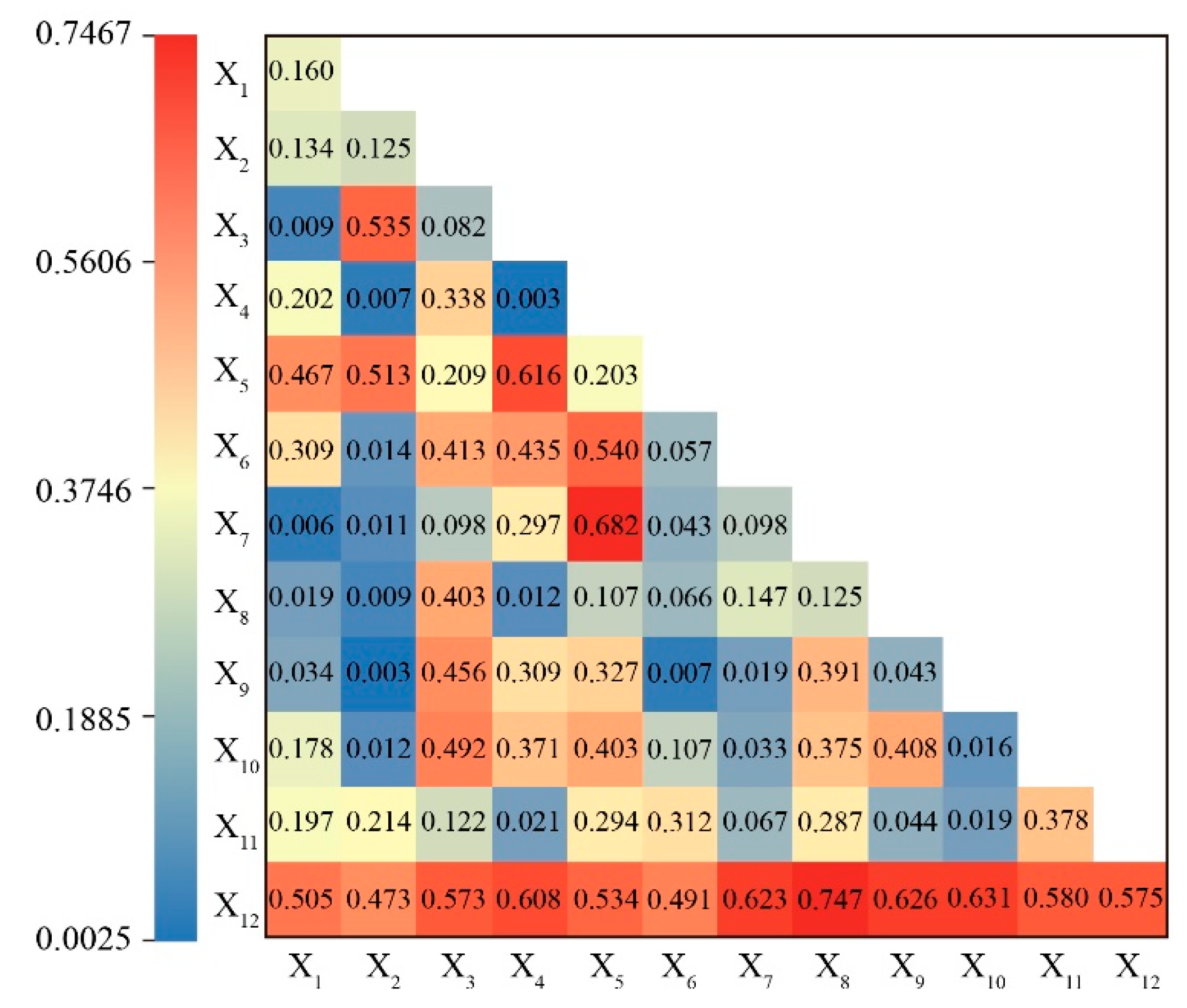

| Dependent Variable | Influence Factor | Independent Variables | Data Source/Description |
|---|---|---|---|
| Habitat quality | Natural environment | Annual precipitation (X1) | China National Meteorological Science Data Center (http://data.cma.cn/ accessed on 12 December 2020) |
| Annual temperature (X2) | China National Meteorological Science Data Center (http://data.cma.cn/ accessed on 12 December 2020) | ||
| Altitude (X3) | National Aeronautics and Space Administration | ||
| Slope (X4) | Obtained by DEM calculation | ||
| NDVI (X5) | Resource and Environmental Science and Data Center of the Chinese Academy of Sciences (https://www.resdc.cn accessed on 12 December 2020) | ||
| Water network density (X6) | Analysis of water system vector data | ||
| Soil type (X7) | National Earth System Science Data Center (http://geodata.nnu.edu.cn accessed on 12 December 2020) | ||
| Socio-economic | GDP per capita (X8) | - | |
| Population density (X9) | - | ||
| Road density (X10) | - | ||
| Nature reserve density (X11) | Geographic Information Database of Specimen Resource Sharing Platform in China Natural Reserve (http://www.papc.cn accessed on 12 December 2020) | ||
| Land use type (X12) | Resource and Environmental Science and Data Center of the Chinese Academy of Sciences (https://www.resdc.cn accessed on 12 December 2020) |
| Threat Factor | Maximum Impact Distance | Weight | Decay Function |
|---|---|---|---|
| Urban land | 10 | 0.9 | Exponential decay |
| Rural residential area | 6 | 0.6 | Exponential decay |
| Other construction land | 5 | 0.5 | Exponential decay |
| Paddy land | 1 | 0.3 | Linear Decay |
| Dry land | 1 | 0.3 | Linear Decay |
| Land Types | Habitat Suitability | Urban Land | Rural Residential Area | Other Construction Land | Paddy Land | Dry Land |
|---|---|---|---|---|---|---|
| Paddy land | 0.3 | 0.5 | 0.6 | 0.5 | 0 | 1 |
| Dry land | 0.3 | 0.5 | 0.6 | 0.5 | 1 | 0 |
| Forest land | 1 | 0.7 | 0.7 | 0.7 | 0.8 | 0.7 |
| Shrub wood | 0.9 | 0.6 | 0.5 | 0.6 | 0.7 | 0.6 |
| Sparse wood | 0.7 | 0.8 | 0.7 | 0.6 | 0.7 | 0.7 |
| Other forest land | 0.5 | 0.6 | 0.7 | 0.6 | 0.4 | 0.5 |
| High coverage grassland | 0.8 | 0.6 | 0.7 | 0.4 | 0.6 | 0.7 |
| Moderate coverage grassland | 0.6 | 0.6 | 0.6 | 0.5 | 0.5 | 0.5 |
| Low coverage grassland | 0.5 | 0.6 | 0.5 | 0.5 | 0.4 | 0.5 |
| River and canals | 0.9 | 0.5 | 0.4 | 0.4 | 0.4 | 0.4 |
| Lakes | 1 | 0.7 | 0.6 | 0.5 | 0.6 | 0.7 |
| Reservoirs and ponds | 0.9 | 0.6 | 0.6 | 0.4 | 0.5 | 0.6 |
| Mudflat | 0.8 | 0.7 | 0.8 | 0.6 | 0.6 | 0.4 |
| Urban land | 0 | 0 | 0 | 0 | 0 | 0 |
| Rural residential area | 0 | 0 | 0 | 0 | 0 | 0 |
| Other construction land | 0 | 0 | 0 | 0 | 0 | 0 |
| Bare land | 0.1 | 0.2 | 0.1 | 0.1 | 0 | 0 |
| Judgment Basis | Interaction |
|---|---|
| Nonlinear decay | |
| Single-factor nonlinear decay | |
| Double-factor boost | |
| independence | |
| Nonlinear boost |
| Year | Land Use Type | Grassland | Construction Land | Dry Land | Paddy Land | Water Area | Forest | Other Land |
|---|---|---|---|---|---|---|---|---|
| 1990–2000 | Grassland | 5384.96 | 0.18 | 82.91 | 6.16 | 1.96 | 41.42 | 4.42 |
| Construction land | 0.01 | 389.39 | 0.13 | 0.58 | 0.03 | 0.03 | 0.02 | |
| Dry land | 1.50 | 13.72 | 5020.58 | 3.36 | 0.72 | 25.55 | 46.55 | |
| Paddy land | 3.34 | 57.58 | 43.89 | 33,756.70 | 34.47 | 41.35 | 525.92 | |
| Water area | 0.64 | 0.28 | 5.50 | 5.02 | 4503.76 | 0.11 | 1.03 | |
| Forest | 101.11 | 1.10 | 72.64 | 29.49 | 0.60 | 20,097.90 | 9.15 | |
| Other land | 0.03 | 2.29 | 0.87 | 9.65 | 5.89 | 0.09 | 4014.12 | |
| 2000–2010 | Grassland | 5413.12 | 13.01 | 1.53 | 13.23 | 1.83 | 26.88 | 21.95 |
| Construction land | 0.02 | 462.75 | 0.21 | 1.04 | 0.16 | 0.19 | 0.17 | |
| Dry land | 1.54 | 58.79 | 5076.01 | 12.81 | 5.06 | 4.42 | 67.79 | |
| Paddy land | 12.69 | 447.48 | 13.43 | 32,578.14 | 119.33 | 77.61 | 562.10 | |
| Water area | 1.70 | 6.25 | 2.42 | 32.63 | 4480.89 | 1.73 | 21.77 | |
| Forest | 22.09 | 29.32 | 6.40 | 78.35 | 1.76 | 20,013.90 | 54.35 | |
| Other land | 0.59 | 17.67 | 6.94 | 56.61 | 10.93 | 1.92 | 4506.54 | |
| 2010–2020 | Grassland | 5313.61 | 3.72 | 3.48 | 33.05 | 5.04 | 72.70 | 20.09 |
| Construction land | 1.66 | 1020.73 | 1.46 | 4.91 | 0.89 | 1.36 | 4.29 | |
| Dry land | 4.36 | 35.48 | 4960.24 | 22.52 | 7.50 | 13.61 | 63.07 | |
| Paddy land | 30.21 | 367.14 | 27.85 | 31,612.94 | 47.94 | 218.57 | 467.63 | |
| Water area | 4.22 | 8.19 | 6.33 | 34.06 | 4533.39 | 5.46 | 27.10 | |
| Forest | 80.01 | 19.13 | 14.70 | 208.76 | 5.01 | 19,751.40 | 45.00 | |
| Other land | 4.91 | 161.94 | 28.24 | 125.99 | 22.45 | 8.20 | 4882.89 |
| Influencing Factors | Land Use Type | NDVI | Slope | Population Density | Water Network Density | GDP per Capita | Soil Type | Altitude | Road Density | Nature Reserve Density | Annual Temperature | Annual Precipitation |
|---|---|---|---|---|---|---|---|---|---|---|---|---|
| q value | 0.638 | 0.382 | 0.305 | 0.217 | 0.139 | 0.103 | 0.087 | 0.043 | 0.036 | 0.033 | 0.015 | 0.010 |
Disclaimer/Publisher’s Note: The statements, opinions and data contained in all publications are solely those of the individual author(s) and contributor(s) and not of MDPI and/or the editor(s). MDPI and/or the editor(s) disclaim responsibility for any injury to people or property resulting from any ideas, methods, instructions or products referred to in the content. |
© 2023 by the authors. Licensee MDPI, Basel, Switzerland. This article is an open access article distributed under the terms and conditions of the Creative Commons Attribution (CC BY) license (https://creativecommons.org/licenses/by/4.0/).
Share and Cite
Cao, Y.; Wang, C.; Su, Y.; Duan, H.; Wu, X.; Lu, R.; Su, Q.; Wu, Y.; Chu, Z. Study on Spatiotemporal Evolution and Driving Forces of Habitat Quality in the Basin along the Yangtze River in Anhui Province Based on InVEST Model. Land 2023, 12, 1092. https://doi.org/10.3390/land12051092
Cao Y, Wang C, Su Y, Duan H, Wu X, Lu R, Su Q, Wu Y, Chu Z. Study on Spatiotemporal Evolution and Driving Forces of Habitat Quality in the Basin along the Yangtze River in Anhui Province Based on InVEST Model. Land. 2023; 12(5):1092. https://doi.org/10.3390/land12051092
Chicago/Turabian StyleCao, Yong, Cheng Wang, Yue Su, Houlang Duan, Xumei Wu, Rui Lu, Qiang Su, Yutong Wu, and Zhaojun Chu. 2023. "Study on Spatiotemporal Evolution and Driving Forces of Habitat Quality in the Basin along the Yangtze River in Anhui Province Based on InVEST Model" Land 12, no. 5: 1092. https://doi.org/10.3390/land12051092
APA StyleCao, Y., Wang, C., Su, Y., Duan, H., Wu, X., Lu, R., Su, Q., Wu, Y., & Chu, Z. (2023). Study on Spatiotemporal Evolution and Driving Forces of Habitat Quality in the Basin along the Yangtze River in Anhui Province Based on InVEST Model. Land, 12(5), 1092. https://doi.org/10.3390/land12051092






